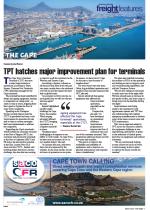The Western Cape’s GDP is expected to grow by 1.8% in 2022 and by 1.9% the year after, with the top forecasted growth sectors being construction, finance and trade.According to David Maynier, Minister of Finance and Economic Opportunities in the province, work has been ongoing to improve the economic outlook of the Western Cape, which was hit hard by Covid-19 – much like the rest of the country.“In 2022, the Western Cape’s economic recovery will exceed 2019 levels,” he told Freight News.In 2020, the GDP growth rate for the Western Cape dropped to -5.7% after the outbreak of the pandemic. Immediate measures to mitigate the impact and improve the economic situation were launched, and last year the province saw growth of 4.3%, showing strong signs of economic recovery. According to Maynier, about 322 000 people lost their jobs between the first and second quarters of 2020. That same year, the tourism sector experienced a gross value added loss of 61% and 75 477 people were left jobless in this sector alone.The alcohol and restaurant industries were just as hard hit in the Western Cape; these industries are estimated to have lost R1.316 billion in sales and 3 972 jobs over the two-week ban imposed during the June 2021 lockdown level 4 period.“To mitigate the impact of the Covid-19 pandemic and to improve the economic situation in the province, numerous initiatives were launched by both the Department of Economic Development and Tourism and the Western Cape government,” said May nier. “The official Western Cape Recovery Plan (first released in March 2021) has been ongoing and is about making the maximum amount of impact on crucial matters affecting our residents and businesses.”Five specific areas have been targeted to make a difference during these difficult times: accelerating ease of doing business initiatives; boosting investment and exports; supporting an infrastructure drive; scaling up work opportunities and skills for people without jobs; and building economic resilience.Maynier said the Western Cape Export Strategy, comprising a trade complexity study, had been well received across the Cape. “The strategy aims to guide export promotion and planning, and to help identify export growth diversification opportunities for the Western Cape. “The outcome of the strategy is a clear approach to doubling exports over the next 10 years from the Western Cape, increasing the number of exporting firms and creating more job opportunities. The approach to support new and emerging exporters is a key lever over the short and medium term and entails matching these businesses with the overall support offered across multiple government partners.”However, Covid-19 has not been the only challenge hampering economic growth. Maynier said energy and water insecurity remained a massive challenge for the Western Cape, which had been severely affected by drought in recent years.“Another major challenge has been logistics and port inefficiencies, impacting on our trade capability,” said Maynier. “Slow reforms and policy uncertainty at a national level, as well as red tape, continue to impact the province as well.”He said efforts to reduce red tape in particular at local and provincial government level had been bearing fruit. “Boosting exports is a key factor in increasing economic demand and employment creation through accessing global value chains and markets. Export growth leads to a favourable trade balance and economic growth as total output increases. “A significant amount of empirical evidence suggests that the export-led growth approach is effective in increasing economic performance.”Boosting exports is a key factor in increasing economic demand and employment creation through accessing global value chains and markets.– David Maynier

